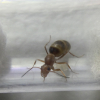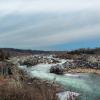1. Location of collection : on pavement outside of the school where I work
2. Date of collection: 7/28/22
3. Habitat of collection : Sidewalk near urban school
4. Length: 10mm
5. Coloration, hue, pattern and texture: All black
6. Distinguishing characteristics :wings still attached, wings look a bit darker than other species I have seen. Looks similar to many Formica Fusca I have caught, though have never seen a formica with wings still attached before
7. Anything else distinctive : Very fat gaster
8. Nest description : N/A
9. Nuptial flight time and date: did not witness flight but wings still attached
Pictures:




















